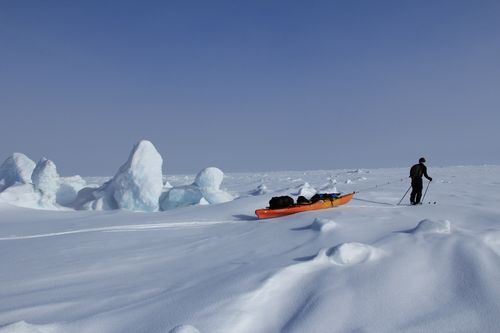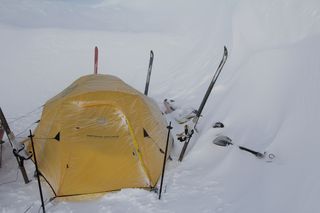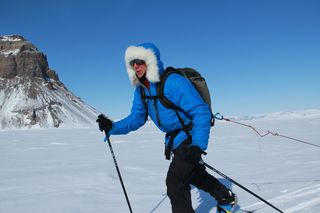
A couple months ago, we ran a Q&A with writer and photographer Erik Boomer, two arctic explorers who were awarded a grant from to become the first team to hike, ski, and then kayak around Canada’s Ellesmere Island. They're two months into their nearly 1,500-mile long expedition and currently stranded on the northeast corner of the 75,000-square-mile island.��
Five days ago, the onset of 50-degree temperatures turned packed ice into thigh-deep slush. Progress slowed to a halt. They crawled, dragging their kayaks behind them, for most of the day and went two miles. The ocean ice remains frozen and too unstable to travel on. With 625 miles left to go, they've stopped and are waiting for the weather to change. ��Turk and Boomer called us from their tent.
So where are you guys?
Turk: We’re near one of the starvation camps of Aldophus Greenly [an American arctic explorer] called Fort Conger. He was with 30 guys when they were stranded here in 1884. They spent a year waiting for a relief ship, and 20 of them starved to death. Like them, we’re trapped in the ice and can’t move.
Boomer: We packed extra food for things like this, so the rest days come as a welcome surprise. I haven’t left the tent today and am setting personal sleep records. We don’t feel like Shackleton, though—just enjoying the free time. It has been nothing but work up to this point.

You guys are okay, yes?
Turk: Oh, yeah. We’re fine. The Canadian Coast Guard has taken a very dear and loving interest in us. We’ve been getting text messages from them with weather forecasts. Right now, the wind’s blowing from the northeast, so the ice flow is pinned against Ellesmere. We’re waiting for the wind to shift to the southwest and blow the ice off the island.
And in the meantime?
Boomer: We’re just watching the ice move from the vestibule. It’s like TV.
Turk: The ice comes in all different sizes, anywhere from a city block in diameter to the size of a baseball. The big ice is flat. The smaller chunks are tilted up at all different angles. Think of it like the ice is in a river. It’s moving, smashing together, rolling over, pushing, surging. Big towers are tipping over. You’d expect it to sound really harsh, but it doesn’t. It’s a kind of soft, deep-throated, whooshing sound. It’s an amazing amount of power.

Sounds kind of pleasant. What will it take for you to get out?
Turk: The more the ice fractures and breaks up, the better chance we have that we’ll have some open water. Right now, we’re talking to scientists and military people, but nobody will tell us when they think the wind will shift. Historically, by mid-July the Nares Strait is 50 to 90 percent clear of ice, which would mean 50 percent water—plenty for us to kayak. Right now, we have 100 percent ice.��
Boomer:��We're eating tons of food and resting.�� It’s going to feel good to paddle and get onto the next stage of this thing. I’m prepared to be out here for another month and a half.
–Kyle Dickman
Photos by Jon Turk��